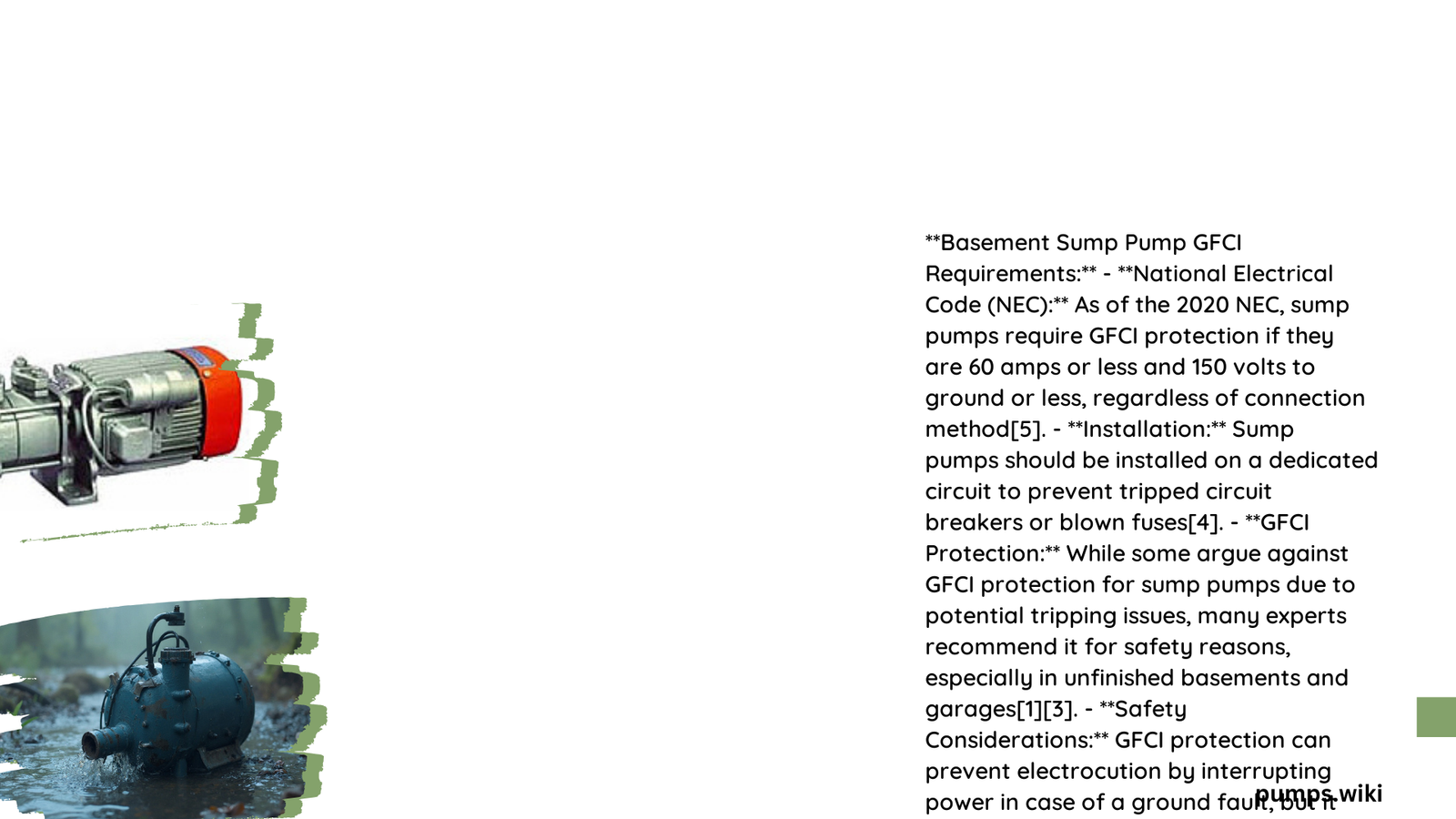Basement sump pump GFCI requirements are critical for ensuring electrical safety in damp environments. The National Electrical Code (NEC) mandates GFCI protection for sump pumps rated 150 volts or less to ground and 60 amperes or less. This protection is essential in unfinished basements and other areas where moisture exposure is likely. Understanding and implementing these requirements is crucial for homeowners and electricians to maintain a safe and code-compliant installation.
What Are the Specific GFCI Requirements for Basement Sump Pumps?
The GFCI requirements for basement sump pumps are outlined in the National Electrical Code (NEC) and are designed to protect against ground faults in potentially damp environments. Here are the key points:
- Voltage and Amperage Limits:
-
GFCI protection is required for sump pumps rated 150 volts or less to ground and 60 amperes or less.
-
Location Requirements:
-
GFCI protection is mandatory in unfinished basements and garages where the risk of ground faults is higher.
-
Installation Height:
- While there’s no specific height requirement in the NEC for GFCI outlets for sump pumps, they should be installed according to general basement receptacle requirements.
-
Typically, they should be accessible and not in areas prone to water submersion.
-
Code Compliance:
- The 2020 NEC specifically lists sump pumps in Section 422.5(A)(6) as requiring GFCI protection.
How to Install a GFCI for a Basement Sump Pump?

Installing a GFCI for a basement sump pump requires careful attention to safety and code compliance. Follow these steps:
- Gather Necessary Tools and Materials:
- GFCI outlet
- Appropriate circuit breaker
- Wire (correct gauge for the circuit)
- Wire nuts or connectors
- Voltage tester
- Screwdriver
-
Drill (if needed)
-
Turn Off Power:
-
Switch off the power to the circuit at the main electrical panel.
-
Verify No Voltage:
-
Use a voltage tester to ensure the receptacle has no power.
-
Remove Old Receptacle:
-
Take out the existing receptacle and disconnect wires.
-
Connect GFCI Outlet:
- Connect black (hot) wire to brass terminal
- Connect white (neutral) wire to silver terminal
-
Connect ground wire to ground terminal
-
Mount GFCI Outlet:
-
Secure the GFCI outlet in the receptacle box.
-
Test and Reset:
- Restore power and test the GFCI by pressing the test button
- Reset the GFCI after testing
What Are the Code Compliance Standards for Sump Pump GFCIs?
The NEC provides specific guidelines for GFCI protection of sump pumps:
- NEC Section 422.5(A):
-
Requires GFCI protection for appliances rated 150 volts or less to ground and 60 amperes or less.
-
NEC Section 422.5(A)(6):
-
Explicitly lists sump pumps as requiring GFCI protection.
-
NEC Section 210.8:
-
Specifies GFCI requirements for branch-circuit outlets in certain locations, including unfinished basements and garages.
-
Class A GFCI Devices:
- Required to trip when 4-6 mA of current leakage to ground is detected.
What Are the Specifications for GFCI Outlets Suitable for Sump Pumps?
When selecting a GFCI outlet for a sump pump, consider these specifications:
- Weatherproof Ratings:
-
Use weatherproof GFCI outlets for damp or wet locations.
-
Trip Levels:
-
Class A GFCI devices must trip between 4-6 mA of ground fault current.
-
Load Capacities:
-
Typically 15-amp or 20-amp ratings to match the sump pump’s requirements.
-
Recommended Models:
- Leviton GFNT1
- GE GFCI outlets
- Eaton GFCI receptacles
| Specification | Requirement |
|---|---|
| Voltage | ≤ 150V to ground |
| Amperage | ≤ 60A |
| GFCI Class | Class A |
| Trip Level | 4-6 mA |
| Typical Rating | 15A or 20A |
What Wire Gauge Should Be Used for Sump Pump GFCI Installations?
The wire gauge for sump pump GFCI installations depends on the circuit amperage:
- For 15-amp circuits: Use 14-gauge wire
- For 20-amp circuits: Use 12-gauge wire
Always ensure the wire gauge matches the circuit breaker rating and the sump pump’s power requirements.
Are There Special Considerations for GFCI Breakers vs. GFCI Outlets?
When deciding between GFCI breakers and outlets for sump pump protection:
- GFCI Breakers:
- Provide protection for the entire circuit
- Installed at the electrical panel
-
More expensive but offer comprehensive protection
-
GFCI Outlets:
- Protect only devices plugged into that outlet
- Easier to install and replace
- More cost-effective for single-device protection
Choose based on your specific installation needs and budget considerations.
How Often Should Sump Pump GFCIs Be Tested?
Regular testing of sump pump GFCIs is crucial:
- Test monthly by pressing the ‘TEST’ and ‘RESET’ buttons
- Ensure the GFCI trips when tested and resets properly
- Replace immediately if the GFCI fails to trip or reset
Regular testing helps maintain the safety and reliability of your sump pump’s electrical protection.
By adhering to these basement sump pump GFCI requirements, you ensure a safe and code-compliant installation that protects against potential electrical hazards in damp basement environments.
